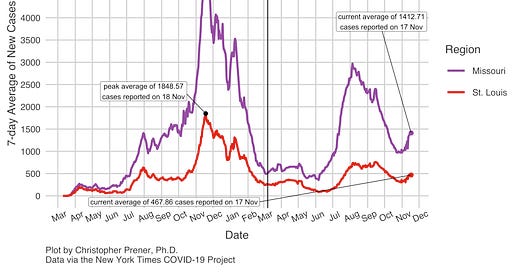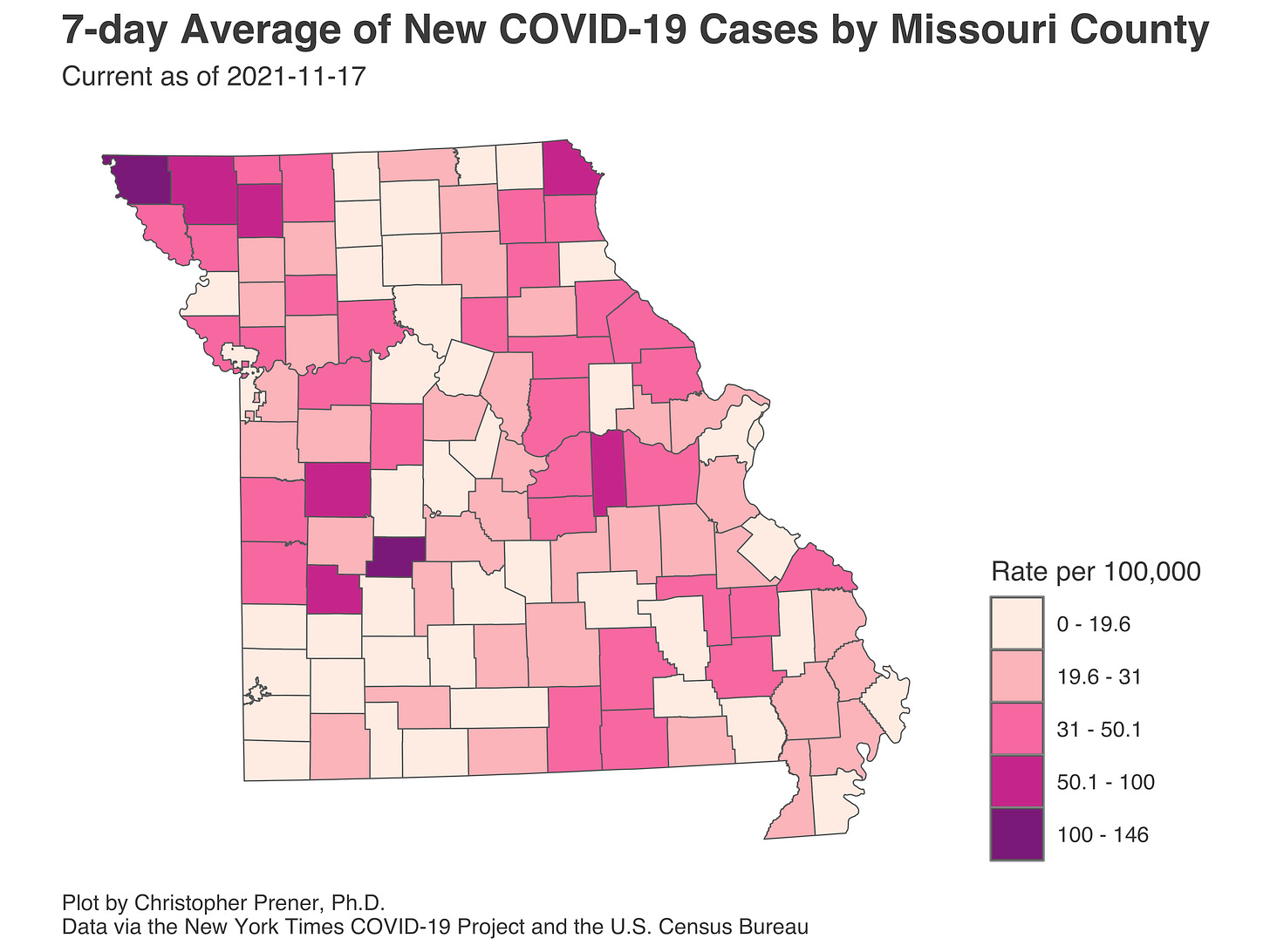Today, we learned that at least 15,198 Missourians have died of COVID-19, several thousand more than we knew of this morning. This revelation came from several additions to the Department of Health and Senior Services’ dashboard. It confirms what I suspected for almost a year, which is that our mortality data are far worse than had been disclosed. At the same time, we learned that breakthrough rates in Missouri are relatively rare, giving us more evidence that vaccines are not just safe but also effective at preventing the poor outcomes we see in people infected with COVID-19.
Unfortunately, all these revisions also mean that our data picture is increasingly chaotic, and we are not likely to have a clear sense of case trajectories again until the end of the first week of December. In light of this, I will not have a newsletter next week but will be back the week after Thanksgiving to take stock of where it seems we sit with transmission and new cases. - Chris
COVID-19 by the Numbers
Total cases in MO: 893,829 (+9,889 from last Thursday)
7-day average of new cases per day in MO: 1,412.71 (+189.86 from last Thursday)
Counties with the highest per capita rates (per 100,000) of new cases per day this past week:
Hickory (146.4 per 100,000), Atchison (119.27), Gentry (81.45), Nodaway (67.16), Clark (65.13), Gasconade (58.13), Henry (56.45), and Cedar (51.25)
Total deaths in MO: 13,135 (+79 from last Thursday)
7-day average of new deaths per day in MO: 11.29 (-9.29 from last Thursday)
Percent of all Missourians initiating vaccination: at least 52% (+1% from last Thursday)
Percent of all Missourians completing vaccination: at least 46% (no change from last Thursday)
Case and mortality numbers are current as of Wednesday, November 17th. Vaccination numbers are current as of Thursday, November 18th. Additional statistics, maps, and plots are available on my COVID-19 tracking site.
Trends in the Past Week
This week, a big challenge is that we have two odd days remaining in our seven-day average. Last Thursday, just 124 new cases were reported in Missouri due to the holiday. Then, last Friday, we overcompensated and added 3,010 new cases. If this sounds familiar, it’s because you have been following my reports for a year now and recall the challenges of last year’s holidays. With last Thursday and Friday, our statewide seven-day average is 1,412.
That seven-day average, as you can see above, is the tip of a pronounced surge in new cases after a steady streak in declines over much of September and October. When you look only at the last five days, the average number of cases is slightly lower at 1,351. This five-day average suggests that much of the spike is genuine and not noise from Veterans Day. One additional piece of evidence suggesting it is continuing are today’s numbers, which will not be factored into my site and plots until tomorrow. According to the Missouri Independent’s Rudi Keller, today saw the first non-holiday with more than 2,000 new cases since September.
We will continue to see these types of data pauses due to holidays next week with Thanksgiving and over the next six weeks with Christmas and New Year’s. Making all of that more complicated is the addition of over 10,000 new cases onto DHSS’s dashboard later today. These cases came from several sources, including people who contracted COVID-19 multiple times. Assuming these cases are factored into the New York Times’ data tomorrow, we will see a repeat of early March 2021 when the public reporting of Antigen positive cases in a single dump distorted our seven-day averages for a week.
This update today is a mixed blessing. Ultimately, the more complete our data picture of COVID-19, the better off we all are. However, when we get large dumps of new cases in the midst of what appears to be a genuine spike in new cases means we lose a whole week of perspective on how the pandemic is progressing. With the upcoming pause in data reporting for Thanksgiving, our data environment was already challenging.
Ultimately, it would mean that it will be the end of the first week of December before we can take stock of where our seven-day averages genuinely are. I worry that, by then, we will be in the midst of widespread transmission from Thanksgiving gatherings and the continued movement of socializing indoors as winter weather returns to our state.
Therefore, the areas of concern tonight will be the best indicator of where our attention needs to be for the next two weeks. Northeastern and Northwestern Missouri, many rural counties between the St. Louis and Kansas City metros (except parts of the Columbia and Jefferson City metros), and parts of the Ozarks are all places to believe that the most widespread transmission is taking place.
The map highlights trends in Hickory County, which show a striking departure from surrounding counties in the Springfield area. However, this appears to be essentially noise from data reporting lags. For example, the New York Times reports 96 new cases there this past week, while the County itself only reports a dozen.
The example of Hickory County captures at a micro level the challenges that we are facing statewide right now in Missouri - inconsistent reporting of data leads to large bumps in new cases that fail to reflect what is happening on the ground. Even in the best times, our data reflect general patterns instead of a complete census of new cases or deaths - they are an indicator of what is happening. However, when these dumps of new cases occur, we lose that indicator for a time.
Another reason our data are just an indicator of what is happening is deliberate limitations on what DHSS reports. One of the best examples of that has been the refusal of DHSS to share probable deaths alongside probable case data. Missouri has reported those probable cases since March 2021, but not the deaths until today. As a result, we learned that 18% of the deaths from COVID-19 in Missouri were unacknowledged by Missouri.
We also saw the first clear disclosures of breakthrough cases in Missouri. Among fully vaccinated individuals, 2% have tested positive for COVID-19 at a later date. Moreover, 0.02% of vaccinated individuals have died. These numbers underscore that breakthrough cases remain relatively rare, though they likely capture only those breakthrough cases that result in more significant symptoms. The key message in these low percentages is that vaccines work.
The DHSS data shows that breakthrough cases are associated with a range of chronic health conditions. These are essential details, but I worry that they are used to absolve us from a collective need to engage in nonpharmaceutical interventions. When we default to asking “but did they have a pre-existing condition,” we blame individuals for their illness or death. Instead, we need to recognize that our collective failure to manage transmission continues to be why we see the morbidity and mortality patterns we have. It is not too late to reduce the burden of illness we are likely to experience over the next two to three months, but it will take political will that has never existed in Missouri.





